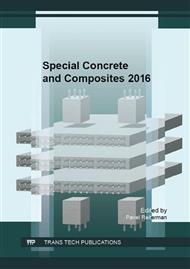p.121
p.126
p.132
p.140
p.146
p.151
p.157
p.163
p.168
Influence of Use Fluidized Fly Ash Combined with High Temperature Fly Ash on Microstructure of Cement Composite
Abstract:
The constraint of using fluidized bed combustion fly ash as addition for concrete is mainly its chemical composition. Increased contents of sulphates and free lime in fluidized bed combustion fly ash causes development of undesirable ettringite during hydration. Expansive character of this mineral can have degrading effect on hardened concrete. Fluidized bed combustion fly ash as well as high temperature fly ash are considered pozzolanic addition, which is capable of reacting with Ca(OH)2 and form similar hydration products as cement hydration. Use of small amount of fluidized bed combustion fly ash can cause production of ettringite, however, when combined with high temperature fly ash, possible micro-failures could be healed with new hydration products - CSH gels. The paper deals with possibilities of confirming this theory mainly through examination of microstructure of cement composite with an electron microscope and clarifying observed hydration products.
Info:
Periodical:
Pages:
146-150
Citation:
Online since:
December 2016
Authors:
Price:
Сopyright:
© 2017 Trans Tech Publications Ltd. All Rights Reserved
Share:
Citation:


